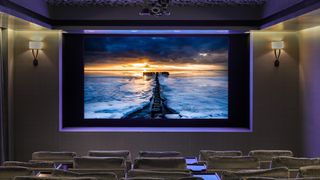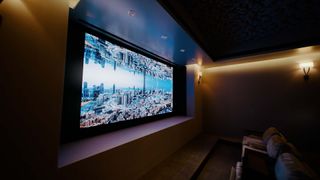Micro-LED 4K TVs aren't trying to kill OLED, they’re aiming at projectors
Cost no-object TV

September turned out to be a banner month for oversize TV announcements, with LG first rolling out its 97-inch G2 OLED at IFA 2022 followed by Samsung with its 98-inch QN100B Neo QLED 4K TV, a high-brightness model capable of 5,000 nits, at the CEDIA custom installation tech show.
If you’re wondering about the cost for each, it is unsurprisingly high. The LG is priced at $25,000 / £22,000 / AU$38,400, and while an official price for the Samsung hasn’t yet been announced, we expect it to be in the $31,000 range. In both cases, the cost gap between the new sets and the best 75-inch TVs and best 85-inch TVs that buyers typically turn to to scratch their oversize TV itch is dramatic enough to push the new models well out of reach for most of us.
But the LG OLED and Samsung Neo QLED were only part of September’s big TV news rush. Visitors to CEDIA 2022 were also treated to the vision of LG’s 136-inch Magnit, a 4K micro-LED “residential display” priced at a sky-high $300,000.
Never to be outdone at a trade show, Samsung had its own MS1A 110-inch 4K micro-LED TV on view. This is one of the company’s “Monolith” designs, so-called because it’s sold as a complete, ready to view unit rather than a collection of modular tiles that professional installers assemble into even larger-sized micro-LED TVs. And at $150,000, the Samsung looks to be the bargain of the two TV behemoths.
Micro-LED is a relatively new TV tech that combines the high brightness of mini-LED with the endlessly deep blacks characteristic of OLED – something it can manage as a self-emissive tech where the pixels in the display are individually controlled.
And while micro-LED has a bright (no pun intended) future as a next-gen TV technology, it’s still many years off from being something regular buyers would ever consider as a potential alternative to regular LED and OLED sets.
Samsung had previously announced plans to produce micro-LED TVs in a wide range of configurations, with the smallest being 76 inches – a common big-screen set size. Those smaller offerings have yet to materialize, although an 89-inch version is reportedly now in production and could be introduced as early as CES 2023.

Are micro-LED TVs the new projectors?
Another product shown at CEDIA 2022 was Sony’s VPL-GTZ380, a 4K projector capable of 10,000 lumens light output. Given typical dim home theater lighting conditions, along with a typical 100- or 120-inch home theater screen size, the Sony’s staggering brightness would appear to be overkill – which is a good reason why it’s priced at $80,000 / £74,700 / AU$122,900.
That’s because Sony’s projector isn’t aimed at typical home theaters, but rather “luxury” ones with even larger screens or open, well-illuminated layouts.
Such rarified spaces are the kind that LG and Samsung are seeking to place their massive micro-LED TVs in. As if to drive that point home, Samsung issued a press release around CEDIA time talking up the home theater of record mogul Clive Davis, which houses the company’s 146-inch The Wall micro-LED TV (see image above).
Will smaller-scale micro-LED sets eventually compete with regular LED and OLED TVs? Only time will tell. In the meantime, anyone looking to get set up with a truly big-screen TV would have been interested in the more modest projector offerings shown at CEDIA 2022 such as Epson’s impressive EpiqVision LS800 ultra short throw projector, a model previously shown at IFA that is priced at $3,499 / £3,080 / AU$5,375 ($4,500 with a 120-inch screen included).
Check out our guide to the best 4K projectors for other more affordable big-screen micro-LED TV alternatives.
Get daily insight, inspiration and deals in your inbox
Get the hottest deals available in your inbox plus news, reviews, opinion, analysis and more from the TechRadar team.

Al Griffin has been writing about and reviewing A/V tech since the days LaserDiscs roamed the earth, and was previously the editor of Sound & Vision magazine.
When not reviewing the latest and greatest gear or watching movies at home, he can usually be found out and about on a bike.
